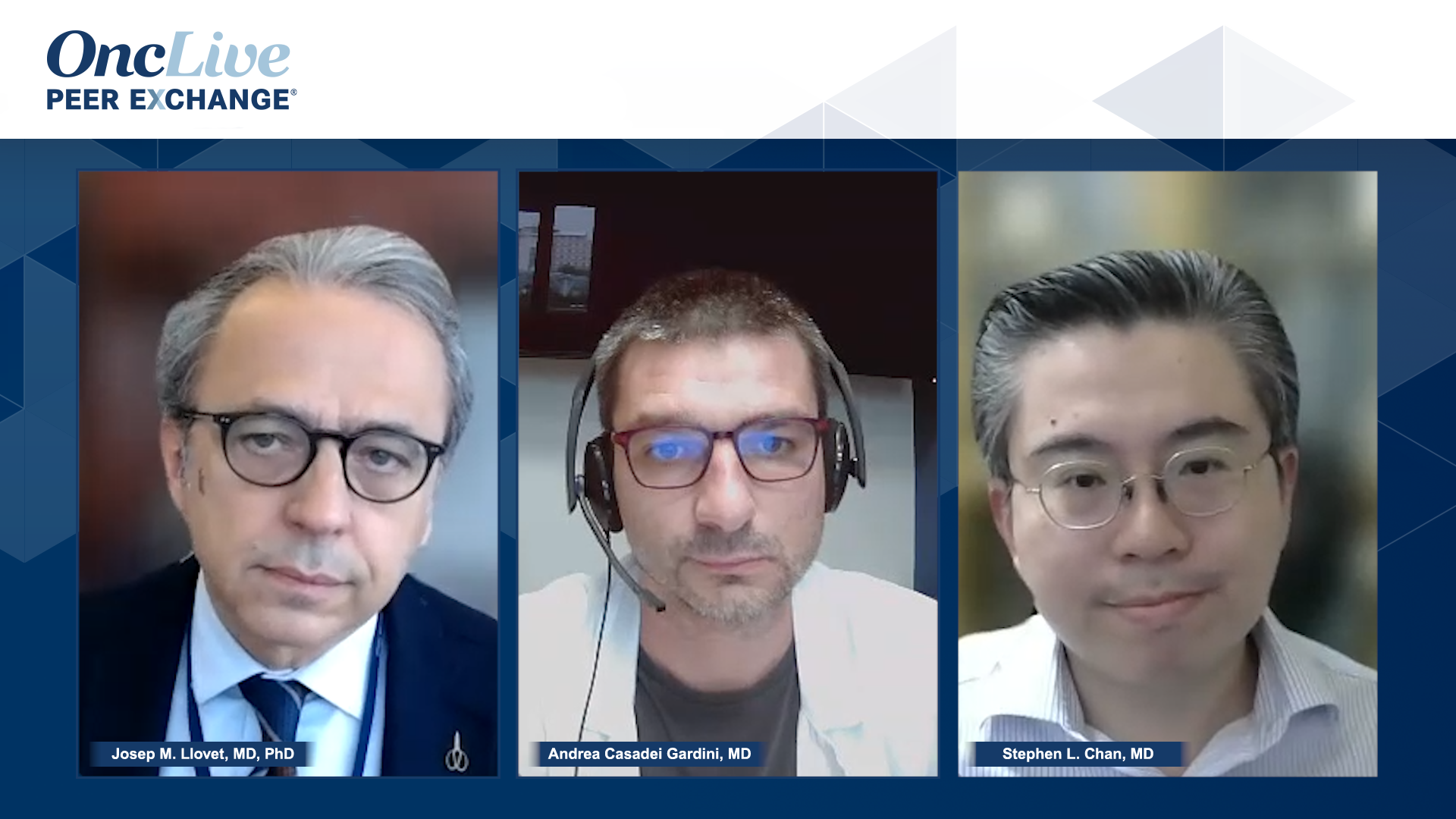- Advertise
- About OncLive
- Editorial Board
- MJH Life Sciences brands
- Contact Us
- Privacy
- Terms & Conditions
- Do Not Sell My Information
2 Clarke Drive
Suite 100
Cranbury, NJ 08512
© 2025 MJH Life Sciences™ and OncLive - Clinical Oncology News, Cancer Expert Insights. All rights reserved.
Updates to Adjuvant and Neoadjuvant Therapy in Early HCC
Stephen L. Chan, MD, reviews the case of a 72-year-old woman with mild alcoholic cirrhosis and provides insight on the potential role of adjuvant and neoadjuvant therapy for the treatment of HCC.
Josep M. Llovet, MD, PhD: Hello, and welcome to this OncLive® Peer Exchange® titled “Emerging Treatment Considerations in Hepatocellular Carcinoma: An Expert Case-Based Discussion.” I’m Josep Llovet, and I’m the director of the liver cancer program and a professor of medicine at the Icahn School of Medicine at Mount Sinai in New York. I’m joined by 2 experts in the field of liver cancer. I’d like to welcome my esteemed fellow panelists. Dr Andrea Casadei, please introduce yourself.
Andrea Casadei Gardini, MD: Thank you. My name is Andrea Casadei Gardini, and I’m an oncologist at San Raffaele Research Hospital in Milan, Italy. I’m the head of the liver unit in the oncology department.
Josep M. Llovet, MD, PhD: Thank you. Dr Steven Chan, please.
Stephen L. Chan, MD: Thank you. I’m Steven Chan. I’m a professor in the department of clinical oncology at the Chinese University of Hong Kong, and I’m a medical oncologist.
Josep M. Llovet, MD, PhD: Thank you for joining me in this discussion about the emerging treatment in HCC [hepatocellular carcinoma]. We’re going to discuss several updates in HCC, including abstracts at ASCO [American Society of Clinical Oncology Annual Meeting] and ESMO [European Society for Medical Oncology Congress] 2021. We’ll also discuss the data of other updates in the treatment landscape and their impact on clinical practice. Let go to the first topic. Is there a role for adjuvant or neoadjuvant therapy in patients with HCC undergoing resection, or ambulatory treatment?
Stephen L. Chan, MD: I’m going to present a patient’s history briefly. We have a 72-year-old woman with a mild alcoholic cirrhosis. An abdominal ultrasound was performed because of an increased gamma GT. Subsequent CT demonstrated liver cancer with a single tumor of 7 cm. There are no vascular invasions or extrahepatic spread. The liver function is Child-Pugh class A, and the ECOG performance status was 0. The liver function, albumin, and the bilirubin were normal, and the alpha-fetoprotein was 20 ng/mL. This patient underwent surgery. The pathologies showed complete recession and confirmed it to be FCC [follicular cell carcinoma].
Josep M. Llovet, MD, PhD: This is framing a classic case in which resection is performed. R0 is achieved by the pathology assessment. The natural history of these patients would be 50% to 70%, with recurrent rate at 5 years. Do we have a choice in terms of primary adjuvant therapy? What do you think about the current data on therapies for this patient?
Stephen L. Chan, MD: This is an important area because in the West, and more likely in the East, our surgeons like to operate on patients with liver tumors, but the criteria for operation may be different. Western surgeons are more selective in terms of selecting the patient for surgery. In the East, our surgeons tend to operate on patients with advanced tumors, bigger tumors, multiferroics…this explains why the recurrence rate and the survival may vary between the East and West and even between different centers. Can we give atrophic treatment for these patients so that we can reduce the recurrences? In the old days, in our center, we participated in a study, adjuvant iodine-131, which showed no improvement in overall survival. In the era of sorafenib, there was the STORM phase 3 study. Unfortunately, the use of sorafenib was unable to prolong disease-free survival, and we found adjuvant use of TTI [time to treatment initiation] was not tolerable. A lot of patients opted for poor compliance. We’re moving toward the adjuvant use of anti–PD-1. Now we have a number of phase 3 trials by different industries, some testing on single use of anti PD-1, some on combinations.… We need data. The regimen works in the metastatic setting or advanced setting, but that doesn’t mean it must work in the adjuvant setting, when there’s no gross tumor. We don’t have a standard, but we eagerly await those phase 3 clinical trials.
Josep M. Llovet, MD, PhD: I concur. After running more than 20 phase 3 trials in this arena, all these trials were negative, except 1 with adoptive immunotherapy. This has not been adopted by guidelines. Unfortunately for this patient, at this point, the decision could be to follow the patient with a regular screening to check for potential recurrence and tag them early. There’s no recommended systemic therapy or operational therapy in the adjuvant setting. There are few studies already reported in the neoadjuvant. These studies are assessing checkpoint inhibitors in a small group of 20 patients. So far, the results are promising, with a readout of pathological response. We need a thorough phase 3 investigation so I could say that the neoadjuvant arena is appealing. It’s scientifically sound, and the preliminary data are promising, but we need additional studies.
Transcript Edited for Clarity


